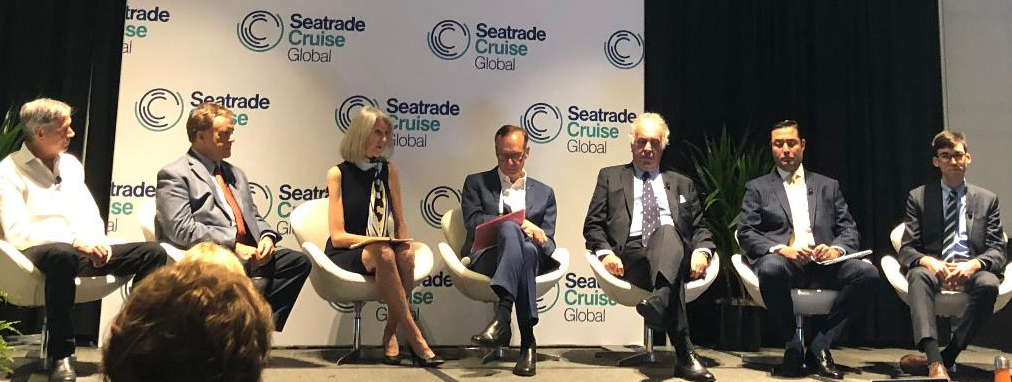
CLIA Alaska’s John Binkley, Ports & Maritime Group International’s Phil Crannell, Seatrade’s Anne Kalosh (moderator), Carnival Corp.’s Giora Israel, Southern Cone Ports Corp.’s Sebastian Montero, Panama Maritime Authority’s Alejandro Agustín Moreno and Windstar Cruises’ Jess Peterson. Photo: M. Pasternak
The Pacific Coast may well be the next big thing in cruise, according to the Rise of the Pacific Coast of the Americas panel at the Seatrade Global Cruise event in Miami last week.
Moderated by Anne Kalosh from Seatrade Cruise Review, the panel featured John Binkley, Cruise Lines International Association Alaska; Phil Crannell, Ports & Maritime Group International (PMG); Giora Israel, SVP port & destination development group, Carnival Corp.; Sebastian Montero, executive director of the Southern Cone Ports Corp.; Alejandro Agustin Moreno, deputy administrator of the Panama Maritime Authority; and Jess Peterson, director – itinerary and revenue planning for Windstar Cruises.
The discussion focused on ports and cruise destinations on the west coast of the Americas from Canada down to the southern tip of South America.
The Pacific coast has not been as developed as the east coast for cruising up until now due to a number of challenges, including seasonality (Alaska), the huge distances between destinations, high costs and regulations and limitations on the size and shape of ships transiting through the Panama Canal.
But a number of recent positive developments in the region could point to a “great future for cruising” noted Kalosh: Alaska is booming; there have been larger, new ships in California; Mexico has recovered after some slow years; the Panama Canal has expanded; there are new berths, ports, and homeports as well as new itineraries; there have been cabotage changes, and there are 115 new build ships in the pipeline, one third of them expedition size ships suitable for smaller ports.
Panama
The development of the Panama Cruise Terminal on Perico Island in Amador Causeway, Panama City is key to adding new cruise options to Central and South America, said Moreno.
The country hopes to begin home-porting ships there, which is the main terminal on the Pacific route of the Panama Canal. In 2018 there were 248 cruises across the Panama Canal; 921,121 cruise tourists arrived in Panama in 2018, up from 768,092 in 2017.
The Panama port executive also said that a memorandum of under-standing had been signed by the governments of Chile and Panama to work together to develop and promote Pacific itineraries that support the new cruise terminal and spoke about the possibility of six- or seven-day cruises between Panama and ports in Colombia, Peru and Chile once the new cruise port is open.
Carnival Corp.’s Giora Israel, who heads up port development for the corporation, stressed that 95% of Carnival’s cruises sail seven-day itineraries. While he said that heading north to Central America from a homeport on the Pacific in Panama would be more attractive due to existing infrastructure, new itineraries heading south might be possible for longer cruises.
Windstar Cruises’ Jess Peterson also noted that his ships already homeport in Panama on the Atlantic side at Colon.
The panelists also discussed the advantages of the new Miraflores cruise port under construction in Lima, Peru.
Alaska
Alaska’s booming cruise business was another highlight of the presentation.
Carnival’s Giora Israel says that growth is currently limited to week-long cruises from two home-ports in Seattle and Vancouver, which can cause the ports to get congested on the weekends. Adding destinations and staggering itineraries can go a long way to avoid the over tourism, he explains.
“One or two new destinations in Alaska can change the whole map. One or two ships sailing Monday to Monday or Friday to Friday can change it as well. I think there are a lot of interesting opportunities,” says Israel.
There was 16% growth in Alaska cruising this year over last year, and it is projected to grow another 7 to 8% this year, with cruise lines starting to invest more in infrastructure, says Binkley.
Michael Pasternak









